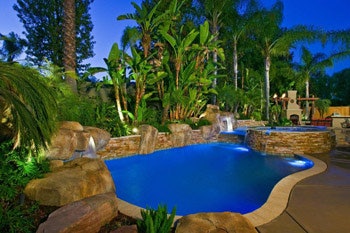

Many AQUA readers have been around long enough to remember when everybody designed pools with paper, pencils and protractors. Some still design that way, and wouldn't dream of doing it differently. Others, however, take advantage of various pool design software systems, which add flexibility and a bit of style to the process. And each year, it seems, the renderings designers produce on the programs get more and more realistic.
Noah Nehlich is the founder and director of operations for Structure Studios, a Las Vegas firm that develops and publishes 3-D pool design software. We recently interview Nehlich about the future of pool design software.
AQUA: Tell us about what's happening in pool design software today.Nehlich: The technology is always changing. Some of the big things that we've done to get the homeowners more emotionally connected to the products is add movement and animation to the software. We have kids playing with balls, people relaxing and enjoying the pool. These add not only depth and scale to the project but they also add life so the people can picture themselves in the design. Also, the trees move in the wind. Little things like that may not seem all that important — they have nothing to do with measuring or anything technical — but as a presentation piece they're really effective.
We've also redone our materials system, so if a pool company inserts a paver pattern or a tile pattern, and they want a custom color to match the house, they can, within our software, custom-tune any surface to be the exact color the homeowner wants, which is another really strong sales tool. You can show them what it's going to look like before ordering any materials. Those are the two big things we've done.
Another thing that's coming out in July will allow a pool company to take a picture of, say, the view from a negative edge. Let's say the house is up on a hill overlooking the city. The pool contractor can take a picture of that view and insert it into the background of the negative edge. It looks ultra-realistic and really sells the idea of taking advantage of the view.
AQUA: Do smartphones or iPads play into your future plans?Nehlich: Five or 10 years from now everybody is going to be on tablet computers; a lot of us won't even have desktop computers anymore, and we're going to be running things strictly off the cloud, or off the Internet. Right now you go to the customer's home, measure, take those measurements, go back to the office and put them into your laptop. The future will be about automating the whole ecosystem of design into on-site design, presentation, costing and even ordering the products on the spot, with the tablet, in a matter of minutes instead of the hours it takes right now.
AQUA: Looking further into the future, where do you see the industry headed?Nehlich: True 3-D is a little ways off, and before that really makes its way into our indsutry they've got to come up with a system where you don't need glasses. I mean, to get the homeowners together and get them all set up with glasses just wouldn't make for a very good experience. We get asked about that from time to time, but the technology is just not there yet.
There are some prototypes out there for TVs and computer monitors that don't require 3-D glasses, but they're pretty jumpy. Once that technology progresses, that's something we'll be keen on implementing into our 3-D software. But in the mean time, we're focused on mobility and moving into the cloud, because that's where all software is headed; and we're investing millions of dollars into making the 3-D effects as realistic as possible, because we want that emotional connection to the product to be as strong as possible in the consumer's mind, and we want them to be able to “test drive” their pools in a totally realistic way.
AQUA: We're doing a profile on Las Vegas builder Joe Vassallo for the August issue. He's using your software then presenting it to some of his customers over the Internet. That strikes us as pretty cutting-edge.Joe is doing the GoToMeeting thing right now, which works great, and we do our training online that same way. But one big drawback of that way of designing, and designing in general, is that it's not a very interactive experience where the user can control the mouse and walk into the project, and things like that. Down the road we'd like to be able to email a fully interactive presentation to the customer that they can access over the web where they can explore the project, jump in the pool and play around with what the pool designers have created instead of just watching a video and watching somebody else control what they're looking at in the project. So that's going to be another way to look at these design projects, and it hasn't been done before in any other industry.











































